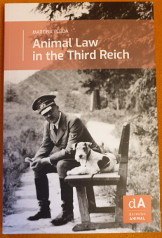When I heard that Martina Pluda had written a book on animal law in the Third Reich, I contacted her about it immediately. I thought it would make interesting reading, and it turns out that I was right.
I know Martina’s passion and attention to detail, which are both essential qualities when tackling such a complex and controversial subject – one that encompasses the analysis of legal texts, their roots, evolution, consequences and impact on present-day legislation.
At a time when there is so much talk about fake news, it is fascinating to see how some of the myths promoted by the Nazi propaganda machine nearly a century ago are still perpetuated and accepted by many people as facts.
Hitler was not a vegetarian, as is sometimes claimed, and animals were brutally killed by Nazi soldiers as part of their training and strategy. However, it is true that during the Nazi era in Germany and Austria various pieces of legislation relating to the protection of the environment and animals were approved, some of which can still be considered progressive all these decades later. Indeed, some articles have been retained because they are seen as valid despite the cruelty and criminality of their authors on other fronts.
In a number of countries, debates and campaigns demanding more protection for natural environments and animals started back in the 19th century. In Germany, where philosophical and ethical principles often merged, such movements were particularly active and fertile.
During the Weimar Republic, legislative progress on animal welfare – as on other issues – slowed down. The National Socialists responded promptly to the strong feelings expressed on this topic by a large proportion of German society by introducing legislation that in some respects was sensible and progressive, although it was partly undermined by exemptions and amendments, and was misused to support the horrors of the Nazi regime.
Martina Pluda’s book “Animal Law in the Third Reich” is published by the Autonomous University of Barcelona, which runs a successful master’s degree programme in Animal Law and Society coordinated by Prof. Marita Giménez-Candela.
Martina has examined legislation and other texts produced from 1933 onwards to offer us a cogent analysis of the evolution of animal welfare legislation in the Third Reich, including references to the historical context in which these laws were produced, their use and misuse, and their influence on modern legislation.
Although animal welfare was not a Nazi invention, it is instructive and rather unsettling to look at the various laws that were approved in those years, starting almost immediately after the National Socialists’ rise to power. Systematic violations of human rights and genocides were planned alongside some measures to protect animals and natural environments.
Let us not be fooled or confused into thinking that these positive legislative developments in any way justify that appalling regime. Some of the proposals had been in the air for years but, as in other matters, the politically unstable Weimar Republic had failed to transform them into law.
Some societal demands for higher environmental and animal protection were finally enshrined in law, but exemptions were soon introduced. Animal experiments were forbidden but – as in other countries – there were derogations based on the researcher’s own assessment of need. A similar law was approved in Italy during the fascist regime. In other words, animal experiments were banned unless the researcher thought they were necessary.
Some protections were granted to companion animals in Germany as early as 1933, including a prohibition against killing them for population control (something that is absent even today in several European countries). Nevertheless, this was followed in 1942 by a law banning Jews from keeping pets, leading to the confiscation and slaughter of large numbers of animals in pursuit of the regime’s perverse aims. Part of the training for SS soldiers was to kill their own dogs.
The law on hunting of 1934 contained some positive elements too, as it was linked to the animal protection law and certain conservation measures, but it fell far short of the mythical abolition of hunting that is sometimes repeated.
Animal rhetoric was often employed in Nazi communications, using ‘strong’ animals to symbolise human ‘virtues’ and presenting ‘weak’ ones as pests to be eradicated. Some years ago, the Israeli newspaper Haaretz published an interesting article on the Nazis’ relationship with their dogs.
There is much more in Martina Pluda’s book, including a useful chronology of events, the philosophical roots of some laws, and a vast bibliography that the keenest readers will find valuable.
A hard copy of the book (which is in English) can be ordered from the website of the Autonomous University of Barcelona (UAB) and an electronic version is available from Unebook.es .
Free subscription to the AnimalWelfareAndTrade Newsletter: click here
Follow AnimalWelfareAndTrade on Twitter: click here
Follow AnimalWelfareAndTrade on Facebook: click here


